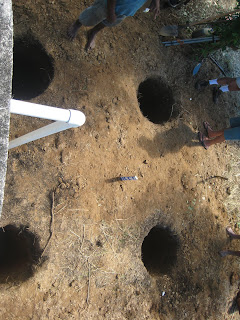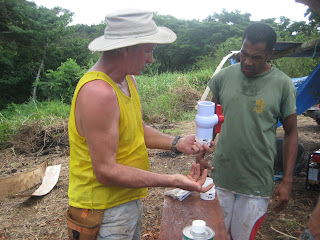Although the village was lucky to have existing piping and storeage to give them running water from two distant sources, a spring and a river, the water looked and tasted dirty. When it rained hard or for long periods of time (which happens frequently in the tropics), the water became so sediment-heavy that it would literally turn white clothes brown if laundry attempts were made (I have first-hand experience with this). As a result, the village would send someone up to the source to divert the river water until it cleared up. This has often lead to water a dry storeage tank (and therefore drought in the village) often for days at a time. Furthermore, when I obtained World Health Organization pathogen water tests (and later other, more sophisticated tests), the results showed dangeous levels of contamination probably due to the wild animal population living in the jungle along the river.
So, in September 2009, I made a contact in the local Rotary Club, an engineer in his former life until he retired and moved to Fiji. I helped my village form a Water Committee, and we got to work on testing our village water usage and water quality (3 months of almost-daily hikes up to the resevoir tank or the source) so the Rotary Club engineer could design a filter for us. At the same time, I trained the leader of our Water Committee (and he got help from the other members) to write a grant, and we finally finished one to the Rotary Pacific Water For Life Foundation (RPWFL) in December 2009.
By February 2010, when the technical portion of the grant application was finished (i.e. when the filter design was complete and we had obtained materials quotes), we submitted our grant.... Soon, however, we learned that RPWFL was no longer accepting applications because of funding issues.Luckily, our Rotary Club partners were able to adapt the original application and submit it to some private contacts, local companies, and rotary clubs around the world. Within days we had pledges for funding.All the money finally came through and we started ordering materials (some from all over the world) in May 2010.
The first week in June 2010, the men of my village started ripping timber (by hand!) for the wood that would be the "community contribution" to the project. We spent the next two weeks in a frenzy of activity as materials were delivered, the tower was constructed, and an elaborate scheme of piping was put in place.
After another week or two the project should be complete, and my community will have water as safe to drink as the bottles they can buy in the grocery store.//Sa Vinaka Saraga. :-)

Headng into the veikau with three chainsaws, some fuel, and a portable radio for day 1 of ripping timber for my village water filtration project.

From the village, our prime timber spot took maybe 45 minutes to hike to.This is Maika, the project's head carpenter, getting the first tree started.

"Vesi" is a gorgeous variety of timber that is very valuable and somewhat rare. Luckily, my village's Mataqali (family clan) has lots of it on their land.

Measuring out the timber so we can mark it for individual plank sizes.

To mark the timber, we opened up an old battery and mixed the black acid with water to make a sort of ink. Then, we used a long piece of string wrapped around a small stick to dip in the ink, stretch accross the timber, and snap against the horizontal surface so as to leave a perfectly straight line for the chainsaw to follow.
did I mention that wood is extremely heavy in these quantities? I am continually amazed at how strong these Fijian men are...
The Varovaro team chills out and takes advantage of a photo opportunity with our last vesi tree.

One of the best moments of my Peace Corps service, hands down, is when one of the ladies carried lunch to us on our last timber day in the bush. She cooked this alternative meat product called "Natrella" with Penne pasta and vegetables. She learned how to cook all of these foods during the "Iron Chef" cooking competition program I led in the village when my mom was visiting in May. If this isn't behavior change, I dont know what is!
Carrying the timber out of the jungle to a road where we can get vehicle access might have been the hardest part of the whole operation.
All of our 2"x6" Vesi planks stacked neatly on construction day 1 at the resevoir storeage tank.
The building plan for our water filter tower basically consists of a two-stage filtration plan. On the tower's deck will sit a plastic water storeage tank that we have filled with a series of rocks, gravel, and sand to act as a roughing (particle) filter. The second stage filtration occurs below when the water comes out of the roughing filter, passes through a series of preliminary screens, and then flows down through two micro filters (for bacteria and viruses) that were purchased from Australia.
The major construction challenge of this project comes from the fact that, in order to work effectively, the 7,600 kg roughing filter (weight when filled with gravel sand and water) must sit a certain distance above the existing storeage tank so that, physics-wise, there will be enough "head loss" (i.e. gravity-induced pressure) to push the water through the entire system.
Day 1: breaking ground on the 1.1 meter deep holes for the treated pine posts to be placed into. The head carpenter, Maika, rolls himself a suki (special tobacco cigarette) while the rest of us are hard at work.
I even dug one of the holes. This was good work for me because Fijian men are HUGE and have a hard time fitting themselves into such a small space!
The four completed holes. You wouldn't be able to imagine how long it took me and the carpentars to square this thing (with no tools except a piece of string and a tape measure).
Day 2 Construction: the treated pine posts are delivered to our job site.
(When I say "we," I of course mean the incredibly strong men from my village... I served as cheerleader, watergirl, and photographer for this portion of the project.)
The Rotary Club guys turned out on this all important materials delivery day to help us drill holes in the right places and place the posts properly for cementing.
Here, the last post goes up...

On day 3, we nogged into the posts and place 3"x10" Vesi bearers into place (there are four on this structure). These bearers might be the most important source of support for this entire structure. The weight of a two-ton truck will be resting on them soon.
After the second round of materials were delivered, we had the plastic tank for our roughing filter, and the builders mix for cement (so we can secure the pine posts in place).
Many many subsequent days were spent placing 14 joists (arranged into 8 bundles for structural security) onto the tower's four bearers.
While the boys are hard at work getting the cement going...

... while I sat down and explained the project to some of the village elders who came to watch us young people work.
Lunch was an unexpected prize that day. We had curry stingray (Kari Vi), dahl soup with fish, boiled taro root (Dalo), and jungle fern (Ota)
Often, the ladies make fresh buns for tea and we enjoy it at a house in between the job site and the village as we make our way home.
Back to work for week 2 of construction...
Maika fits the pieces of freshly, hand planed, decking together to ensure as-even-as-possible surface for our roughing filter to sit on.
Hand planing 4 sides of each piece of decking takes a LOOOOOONG time!
This tribute reads "In memory of them who died with milika."Milika is my Fijian name.
The boys mean to say that I've worked them to death (by making them plane so many pieces of wood) and so this water tower is a memorial to that sacrifice.
The last day of week 2 construction, Jeff (the Engineer from the Savusavu Rotary Club) and Steve (Chapter President of the Savusavu Rotary Club) came back to deliver the micro-filters and help us install a ton of new piping.
Steve drills some connection for draining and water flow into the roughing filter tank while I secure the fitting from inside.
At the moment I'm the only non-child who is both small enough and brave enough to climb through the fresh-cut manhole and sit inside the plastic storeage tank. All I can say is that it's VERY hot in there!
The last big task of week 2: getting the roughing filter tank on to the structure itself...
up it goes...
The final piping scheme (looking a lot like an outerspace rocketship-type mechanism) the way we left it at the end of construction week 2.
So, that's where the water project is so far. I'm in the capital city for some workshops and an annual Peace Corps Fiji Conference for two weeks. While I'm gone the boys are collecting sand for the roughing filter and cleaning the existing tank. When I get back we should have about one more week of work (cleaning sand and getting it inside that plastic tank, mostly) before my project is finished.
More info to come...
Vinaka Vakalevu for reading my blog.
I love you all.
xx
Milika
:-)






































Very good.
ReplyDeleteWow, the experiences, and the photos, INCREDIBLE!!! Mom
ReplyDelete